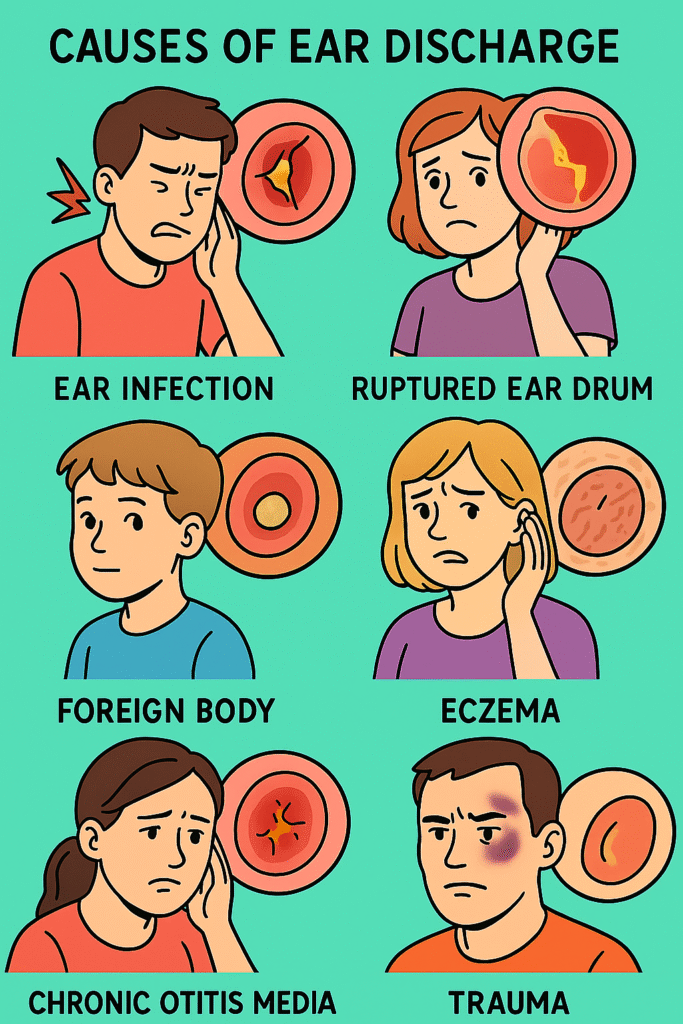Ever noticed fluid coming out of your ear and wondered if it’s something serious? Ear discharge—also known as otorrhea—can be alarming, especially if it’s smelly, bloody, or persistent. But not all discharge is dangerous. Sometimes, it’s just your body doing its job. Other times, it’s a red flag for something more serious.
Let’s break it down in plain language.
What Is Ear Discharge?
Ear discharge simply refers to any fluid that comes out of the ear. It might be:
- Clear or slightly yellowish (like earwax)
- Cloudy or pus-like
- Bloody
- Watery
- Foul-smelling
A little wax is totally normal—it’s your body’s way of cleaning and protecting the ear. But if the fluid is unusual, excessive, or accompanied by other symptoms (like pain or hearing loss), it might be a sign something’s wrong.
How Does It Happen?
Think of your ear like a tunnel with three parts: outer, middle, and inner ear. Normally, earwax traps dust and keeps bugs out. But when infection or injury strikes—especially in the middle ear—fluid builds up behind the eardrum. If the pressure gets too high, the eardrum might even rupture, and that fluid leaks out.
Other times, water or bacteria get trapped in the outer ear (like after swimming), leading to infections that cause discharge too.
What Causes Ear Discharge?
There are many reasons why you might get ear discharge. Here are the most common:
1. Ear Infections (Otitis Media or Otitis Externa)
- Otitis media (middle ear infection): Often follows a cold or allergy. Pus or fluid builds up and may leak if the eardrum bursts.
- Otitis externa (a.k.a. swimmer’s ear): Bacteria grow in moist ear canals. You may see clear or pus-like fluid.
2. Ruptured Eardrum
- Caused by infections, loud sounds, trauma (e.g., poking ear with a cotton bud), or sudden pressure changes.
- Often comes with sudden pain, followed by bloody or pus-filled discharge.
3. Foreign Object
- Kids especially might stick beads or toys in their ears. These can cause infection and discharge.
4. Chronic Suppurative Otitis Media (CSOM)
- A long-standing ear infection that doesn’t go away.
- Common in children and low-resource settings.
- Discharge may be persistent, smelly, and accompanied by hearing loss.
5. Skin Conditions (e.g., eczema or dermatitis)
- Can affect the ear canal and cause flaky or wet discharge.
6. Trauma or Surgery
- A cut in the canal or healing after surgery can leak fluid temporarily.

Risk Factors
Anyone can get ear discharge, but some are more likely than others.
- Young children (narrow Eustachian tubes make it harder to drain fluids)
- Frequent swimmers (moisture encourages bacterial growth)
- People with allergies or colds
- Poor hygiene or frequent earbud use
- History of ear infections or ear surgery
- Use of hearing aids or earplugs for long periods
Other Symptoms to Watch For
Ear discharge is often just one part of the picture. Here’s what else to pay attention to:
- Ear pain
- Hearing loss
- Fever
- Dizziness or balance issues
- Itching or redness
- Bad smell from the ear
- Feeling of fullness in the ear
If the discharge is bloody, green/yellow, or smells foul, it likely points to an infection. Sudden loss of hearing or severe pain? Don’t wait—see a doctor.
Tests to Identify the Cause
The gold standard for diagnosing ear discharge causes is a physical examination using an otoscope (a lighted tool used to look into your ear).
Depending on what’s found, your doctor might also suggest:
- Ear swab for lab analysis (to identify bacteria or fungus)
- Hearing tests
- CT scan (in complex or chronic cases)
- Tympanometry (to check pressure behind the eardrum)
Treatment for Ear Discharge
Treatment depends on what’s causing it. Here’s how it usually goes:
✅ Ear Infection (Otitis Media/Externa)
- Antibiotic ear drops or oral antibiotics
- Pain relievers like paracetamol or ibuprofen
- Keep ears dry (no swimming until healed)
✅ Ruptured Eardrum
- Often heals on its own within a few weeks
- Keep the ear dry
- If infected, antibiotics may be given
- Surgery (tympanoplasty) may be needed in severe or chronic cases
✅ Foreign Object
- Must be removed carefully, especially in children
- Followed by cleaning and possible antibiotics if infection is present
✅ Chronic Discharge (CSOM)
- Long-term antibiotics
- Possible surgery (like mastoidectomy or tympanoplasty)
Avoid inserting cotton buds or ear candles. They often do more harm than good.
References
- Otorrhea: Background, Pathophysiology, Etiology – Medscape, July 2023. https://emedicine.medscape.com/article/860028-overview
- Ear Discharge – Symptoms and Causes – NHS Inform, 2022. https://www.nhsinform.scot/illnesses-and-conditions/ears-nose-and-throat/ear-discharge
- Otitis Media (Middle Ear Infection) – Centers for Disease Control and Prevention (CDC), Jan 2023. https://www.cdc.gov/antibiotic-use/community/for-patients/common-illnesses/ear-infection.html
- Swimmer’s Ear (Otitis Externa) – Mayo Clinic, 2023. https://www.mayoclinic.org/diseases-conditions/swimmers-ear/symptoms-causes
